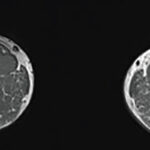A 13-year-old black male, described by his mother as a very active and energetic child, is referred to a pediatric rheumatologist. His chief complaint is muscle pain in both legs, which he has experienced for the past three weeks. His mother is a patient of an adult rheumatologist at this clinic and is quite concerned.
The boy says his pain is 6 out of 10. Taking acetaminophen twice during the day and once at bedtime provides some relief. His pain has increased over the past three days without relief, and at times was so severe he cried and stayed up at night. Today, his pain is better. He has no history of previous illness or allergies. He denies any sports accidents. He has had no swelling or bruising. He has no history of stomach pain, diarrhea, rash, fever, weight loss, eye problems, hearing problems, urinary problems, chest pain or cough.
Drug allergy: He has no known drug allergies.
Medication: He takes acetaminophen as needed for muscle pain, but no other prescribed or OTC meds or supplements.
Family history: The boy’s grandfather has osteoarthritis. His grandmother has hypertension. His mother has mild RA, and he has a brother with a diagnosis of ADHD.
Social history: He lives with his mother, father, two sisters, a brother and an uncle. They have two dogs and a cat. He is the top of his class at school, but has been limited in PE for the past few weeks because of the pain.
Physical Examination
Vital signs: Weight 148 lbs.; height 5 feet and 9 inches; temperature 98.8° F; pulse 96; and blood pressure 62/45.
General: The patient is cooperative, alert, talkative, active and in no distress.
HEENT: There are no signs of tonsillitis. His ear canals are clear, his pupils are reactive to light, and the oral mucosa is clear.
Skin: He has some signs of acne.
Chest: Clear
Heart: He has a regular rhythm with no murmur.
Abdomen: His abdomen is soft and nontender, with no masses or organomegaly.
Musculoskeletal: The patient has slight limitation in neck rotation and lateral bending, but normal flexion and extension. All peripheral joints have full range of motion and no synovitis, effusion or tenderness. His muscle strength is 5/5 proximally and distally in his arms and legs.
Laboratory data: Lab tests from the primary care physician show an arthritis panel with normal uric acid, rheumatoid factor of 7 and negative antinuclear antibody. The CBC, chemistry panel, CK and ESR are normal.
Diagnosis: Leg muscle pain, noninflammatory. Obesity.
Plan: I do not see any problems at this time with his laboratory or physical examination. His pain may be related to growing pains. The mother admitted that the primary care physician came to the same conclusion, but she wanted a second opinion. The mother also said then that she changed to new pillows and mattress a month ago, because her son grew considerably over the summer.
The pediatric rheumatologist recommends that the patient take 200 mg ibuprofen up to four times a day and use a heating pad on his leg muscles as needed, with caution to avoid burns. She encourages the boy to remain active. In her note to the primary care physician, she recommends counseling about weight loss and exercise.


